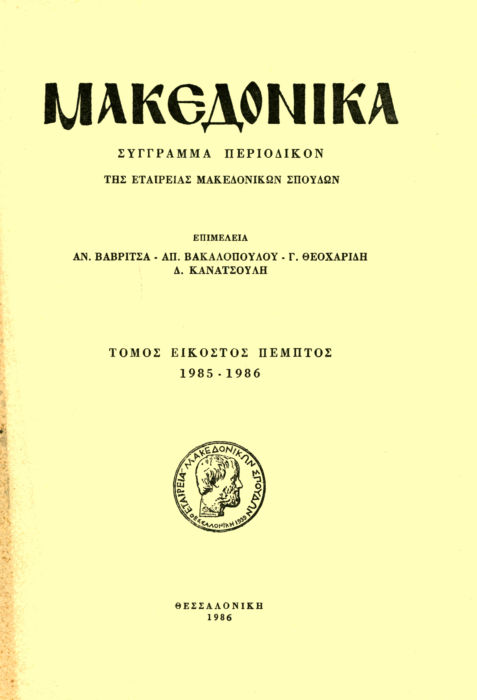A new Macedonian tomb in Thessaloniki
Abstract
In the autumn of 1983 a new Macedonian tomb was brought to light in
Thessaloniki, during excavations for laying the foundations at a building site in the area of Charilaou. It is a one chamber building made of porous stone, coated with whitish mortar. It has an architectural simple facade but a completely unusual arch, wholly constructed by drums of Doric columns in second use. Steps, carved in the natural rocky ground, lead to the doorway which was shut off by three boulders, while from the inside i t would shut by a wooden door.
The grave, which was already looted in the antiquity, has interior dimensions 3,15 X 3,33 m. The space of the chamber is nearly all taken up by three funerary bed-sarcophagus built by porous stone in the shape of Π. The sarcophagus at the right (A) was constructed first. On its long side are shown in relief the cross-beams and the two feet of the bed.
This monument was probably a family vault: at least four persons were
buried successively there, however the plunderers’ intervention who scattered the bones and burial objects, makes difficult the identification of the burials and objects. In the interior though of the sarcophagus at the left (Γ) have been found remains of the wooden stretcher where the body had been laid. The grave must have been constructed at the first half of the 3rd cent. B.C. but has been used at least until early in the 2nd cent. B.C., as shown also by the burial objects that have been saved: simple clay vases, mostly unguentaria but also lamps, pyxides, two amphorae a female figurine, alabasters, a coin and other small objects.
Article Details
- How to Cite
-
Τσιμπίδου-Αυλωνίτη Μ. (1986). A new Macedonian tomb in Thessaloniki. Makedonika, 25(1), 117–142. https://doi.org/10.12681/makedonika.225
- Issue
- Vol. 25
- Section
- Articles

This work is licensed under a Creative Commons Attribution-NonCommercial-ShareAlike 4.0 International License.
Authors who publish with this journal agree to the following terms:
- Authors retain copyright and grant the journal right of first publication with the work simultaneously licensed under a Creative Commons Attribution Non-Commercial License that allows others to share the work with an acknowledgement of the work's authorship and initial publication in this journal.
- Authors are able to enter into separate, additional contractual arrangements for the non-exclusive distribution of the journal's published version of the work (e.g. post it to an institutional repository or publish it in a book), with an acknowledgement of its initial publication in this journal.
- Authors are permitted and encouraged to post their work online (preferably in institutional repositories or on their website) prior to and during the submission process, as it can lead to productive exchanges, as well as earlier and greater citation of published work (See The Effect of Open Access).



